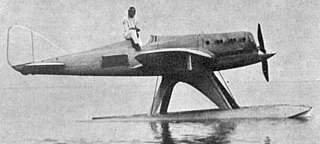Related Research Articles
Matra was a major French industrial conglomerate. Its business activities covered a wide range of industries, notably aerospace, defence, automotive, motorsports, transport and telecommunications.

ALARM is a British anti-radiation missile designed primarily to destroy enemy radars for the purpose of Suppression of Enemy Air Defenses (SEAD). It was used by the RAF and is still used by the Royal Saudi Air Force. The weapon was retired by the UK at the end of 2013.

The Crotale is a French, all-weather, short-range surface-to-air missile system developed to intercept airborne ranged weapons and aircraft, from cruise or anti-ship missiles to helicopters, UAVs or low-flying high-performance fighter aircraft. It was developed by Thomson CSF Matra and consists of a mobile land-based variant as well as various naval ones.

The Martel is an Anglo-French missile. The name Martel is a contraction of Missile, Anti-Radiation, Television, referring to the guidance options. There are two variants, the passive radar anti-radiation missile version, AS.37, and the television guided anti-ship missile, AJ 168.

The Dassault Super Mystère is a French supersonic fighter-bomber and was the first Western European supersonic aircraft to enter mass production.

The Socata TB 30 Epsilon is a light military trainer aircraft produced by SOCATA. It is a tandem two-seater with a metal airframe. The first prototype flew on 22 December 1979.

The Arado Ar 96 was a single-engine, low-wing monoplane of all-metal construction, designed and produced by the German aircraft manufacturer Arado Flugzeugwerke. It was the Luftwaffe's standard advanced trainer throughout the Second World War.
The Arsenal VB 10 was a French fighter-interceptor aircraft developed during and shortly after World War II. It was a low-wing monoplane with retractable tailwheel undercarriage and of largely orthodox configuration. The ultimate product of a design that began with the Arsenal VG 10 prior to the war, the VB 10 added a second engine behind the cockpit which drove a second propeller, coaxial with and contra-rotating to the propeller driven by the engine in the nose.

The Caudron C.690 was a single-seat training aircraft developed in France in the late 1930s to train fighter pilots to handle high-performance aircraft. It was a conventional low-wing cantilever monoplane that bore a strong resemblance to designer Marcel Riffard's racer designs of the same period. Caudron attempted to attract overseas sales for the aircraft, but this resulted in orders for only two machines - one from Japan, and the other from the USSR. In the meantime, the first of two prototypes was destroyed in a crash that killed René Paulhan, Caudron's chief test pilot.

The Morane-Saulnier AR was a trainer aircraft produced in France during and after the First World War.

The Potez 53 was a French low-wing enclosed cockpit single-seat cantilever monoplane racing aircraft built by Potez to specifically to compete in the 1933 Coupe Deutsch de la Meurthe race, which it won outright.

The Potez 75 was a low-cost, simple, ground-support, observation and launch aircraft for anti-tank missiles, designed and built in the early 1950s, for use in colonial conflicts. One hundred and fifteen were ordered in 1956, but cancelled in 1957.

The Dewoitine D.513 was a 1930s prototype French monoplane fighter designed and built by Dewoitine.

The SNCASO SO.9000 Trident is a French jet and rocket powered interceptor aircraft built by aircraft manufacturer SNCASO during the 1950s. As part of a wider effort to re-build French military power during the late 1940s and to furnish France with advanced, new domestically produced designs, a request for a supersonic-capable point-defence interceptor aircraft to equip the French Air Force was issued to SNCASO. In response, the firm designed the mixed-propulsion Trident, powered by a single SEPR rocket engine, which was augmented by wingtip-mounted turbojet engines, and the Air Force ordered two prototypes.

The Bernard H.V.41 was a racing seaplane designed by Société des Avions Bernard for the French government to compete in the 1929 Schneider Trophy.

The Bernard H.V.42 was a racing seaplane designed by Société des Avions Bernard for the French government for use of the French Schneider Trophy team.
Groupe de Chasse or groupe de chasse is the French language term for "fighter group" or "fighter wing". More literal translations include "pursuit group" and "hunting group".

The Potez-CAMS 161 was a large, French six-engined flying boat airliner, designed to operate on the North Atlantic routes that were opening up in the late 1930s. Its development was almost halted by World War II. Just one was built and partially tested before its destruction by Allied forces near the war's end.

Flotille 4F is a French Aeronavale aircraft squadron based at Base Aéronavale de Lann Bihoué and equipped with three Northrop Grumman E-2C Hawkeye aircraft, these aircraft are operated from the aircraft carrier Charles de Gaulle.

The SNCAC NC.1070 was a piston engined attack and torpedo bomber designed and built in France shortly after World War II. The second prototype, the NC1071, was the first French multi-jet turbine powered aircraft.
References
- 1 2 3 4 5 Freidman 1997, p. 224.
- ↑ Pretty 1983, p. 189.
- ↑ Hewson 2003, p. 154.
- ↑ Friedman 1997, pp. 248–249.
- ↑ Hewson 2003, pp. 238–241.
- 1 2 3 4 5 Friedman 1997, p. 224.
- 1 2 3 4 5 6 7 8 9 10 Hewson 2003, p. 143.
- ↑ de Guillebon Le Fana de l'Aviation February 2017, p. 20.
- ↑ de Guillebon Le Fana de l'Aviation February 2017, p. 18.
- ↑ de Guillebon Le Fana de l'Aviation April 2017, p. 64.